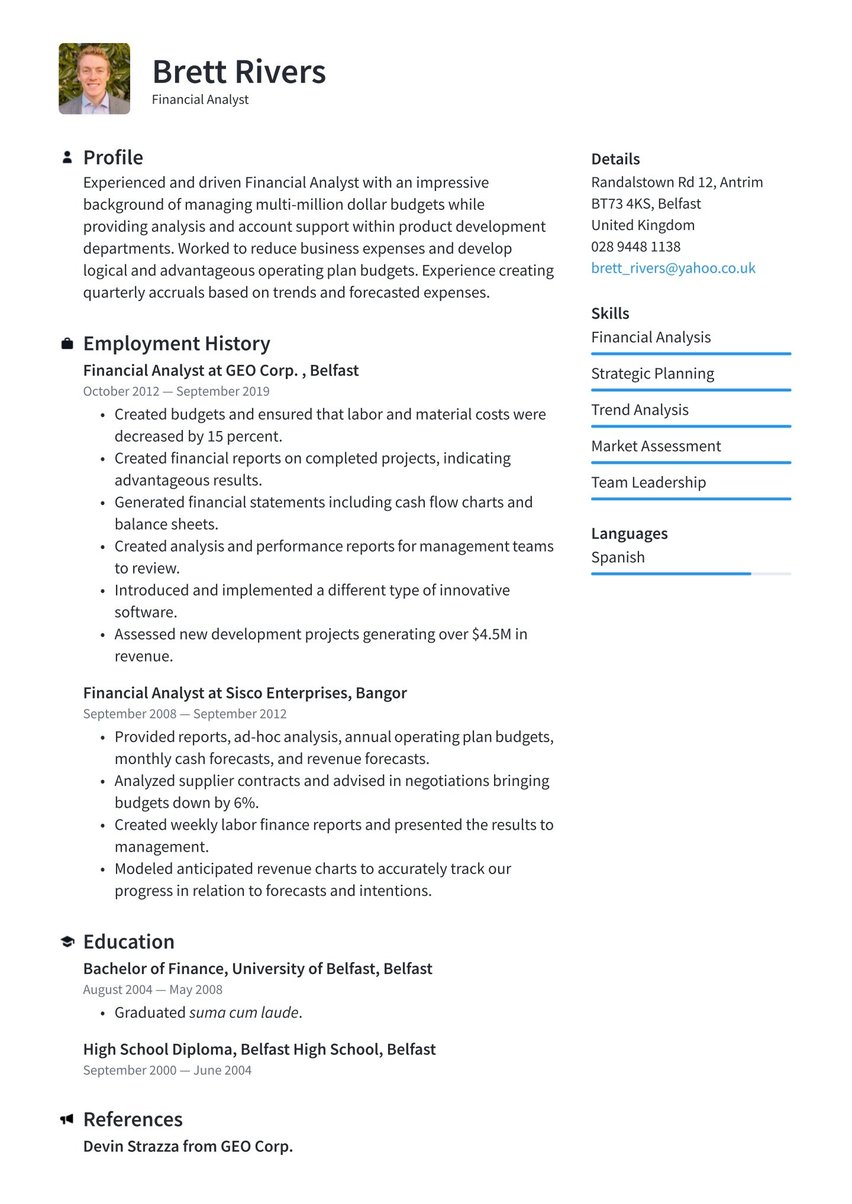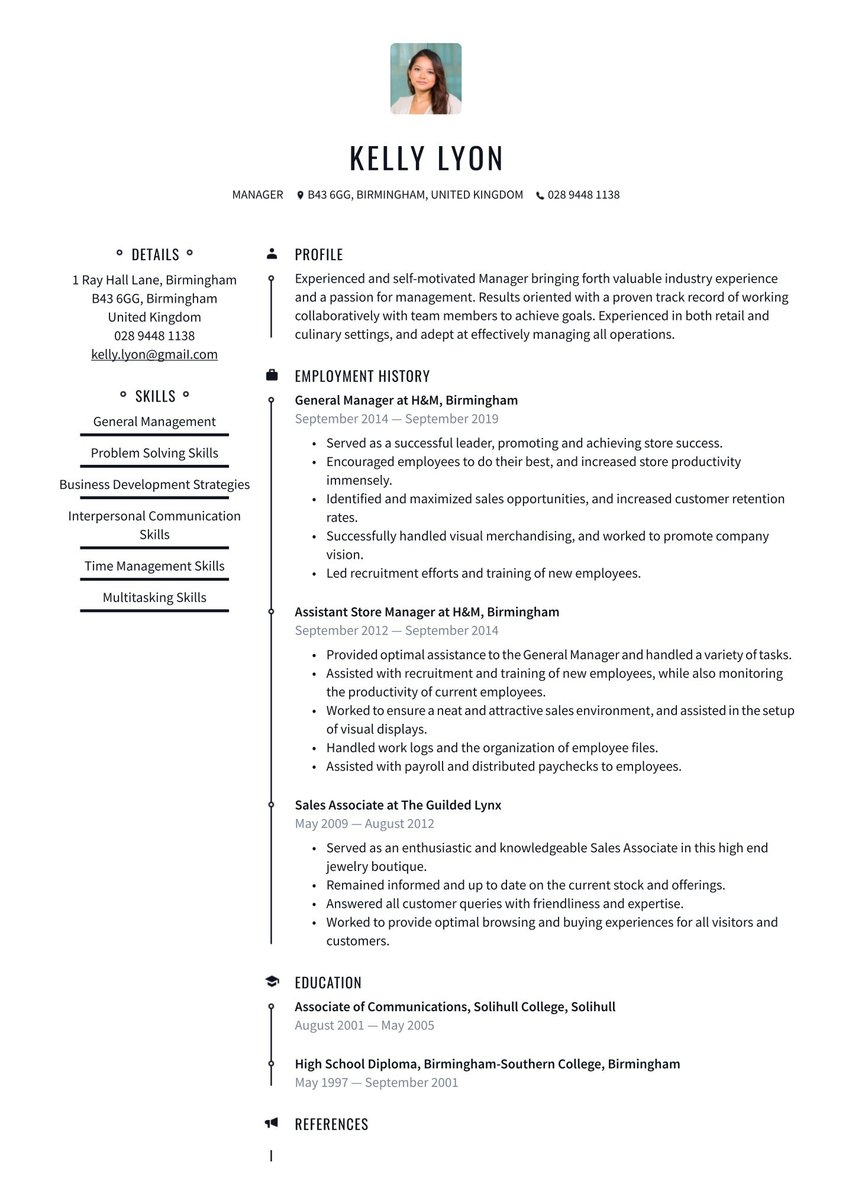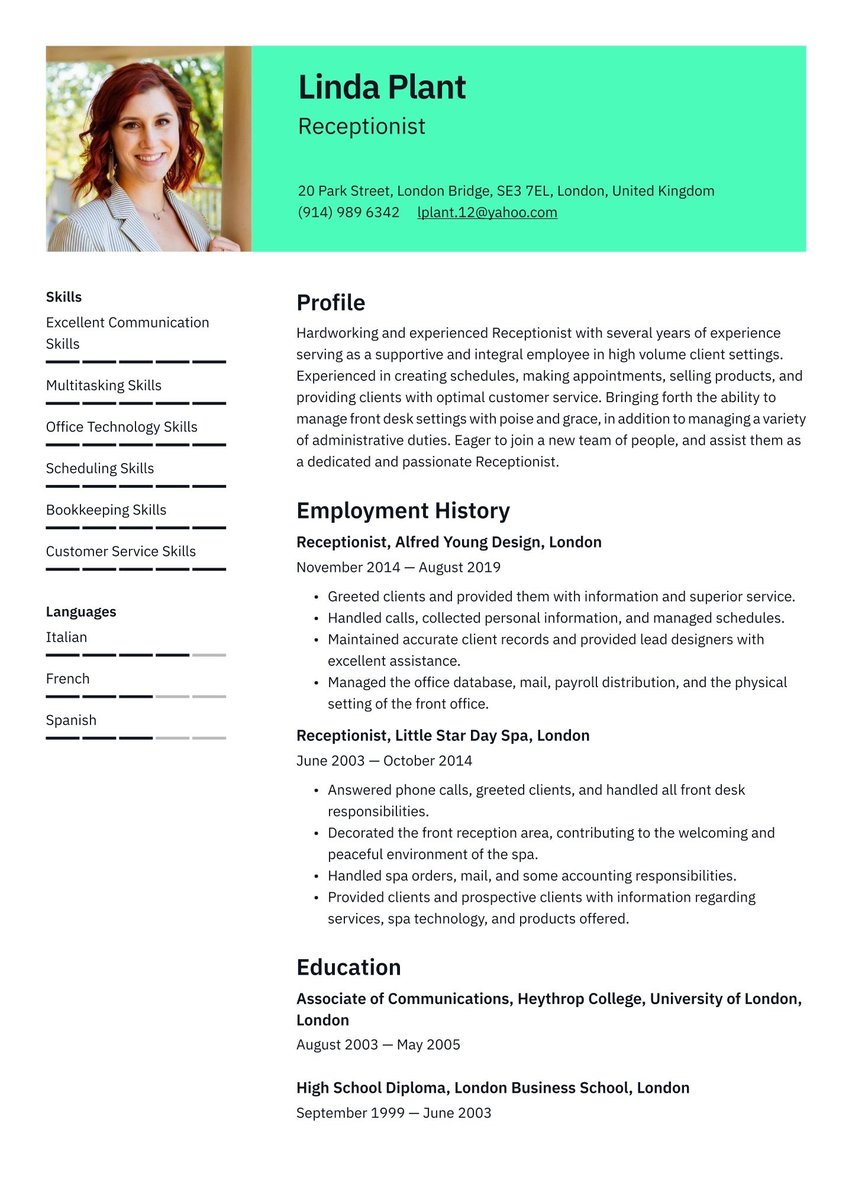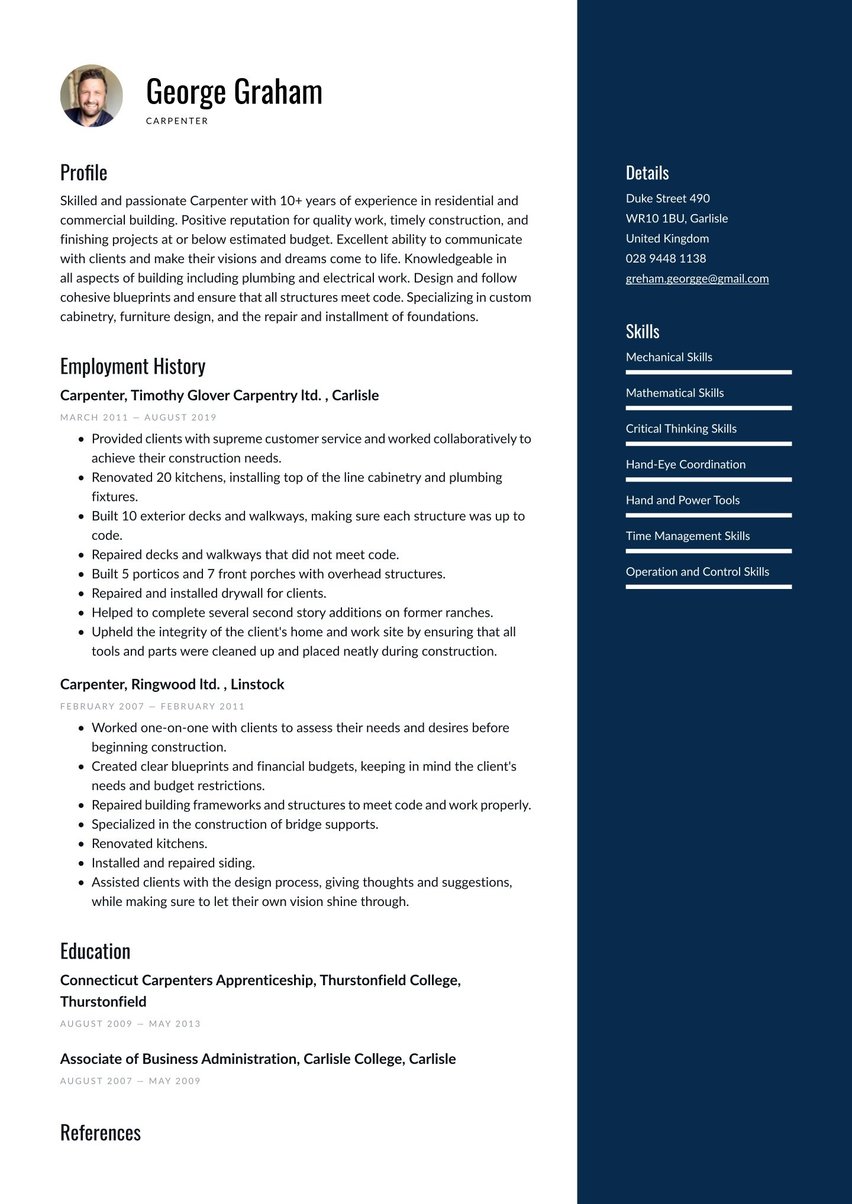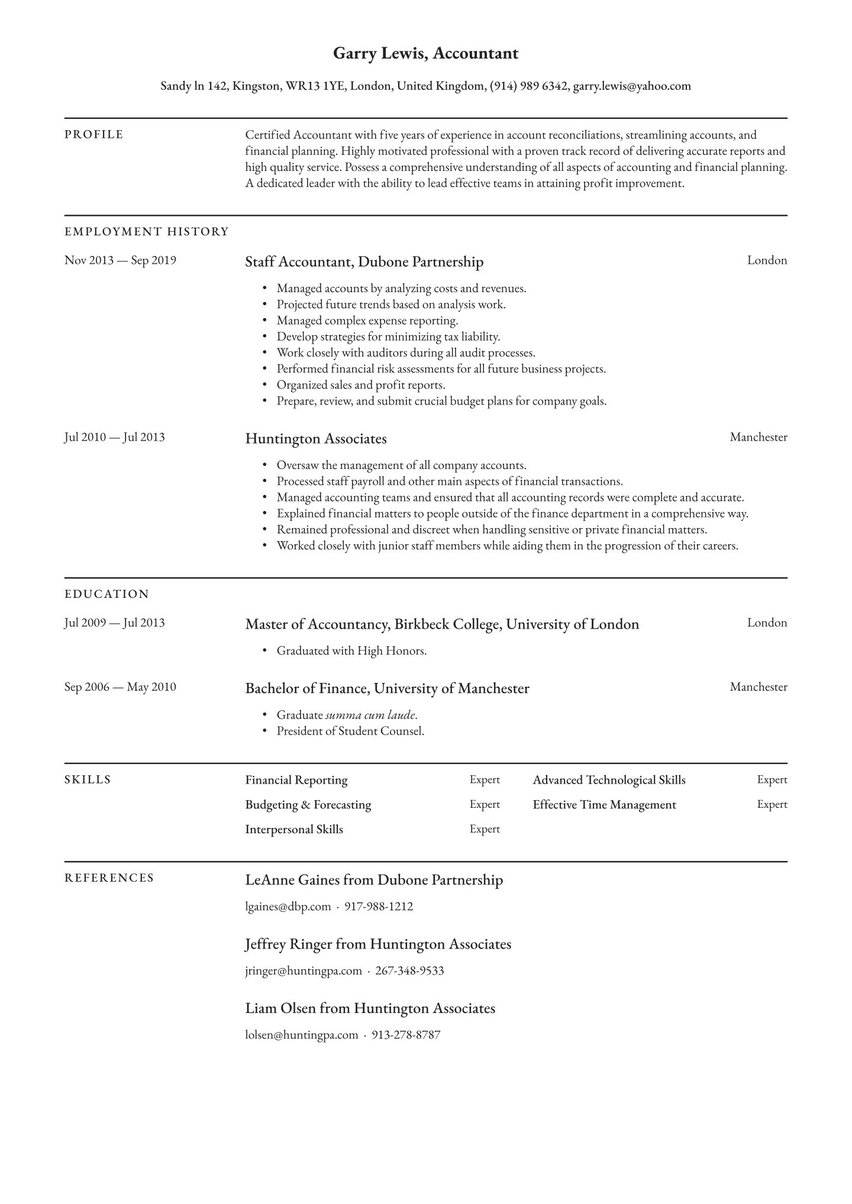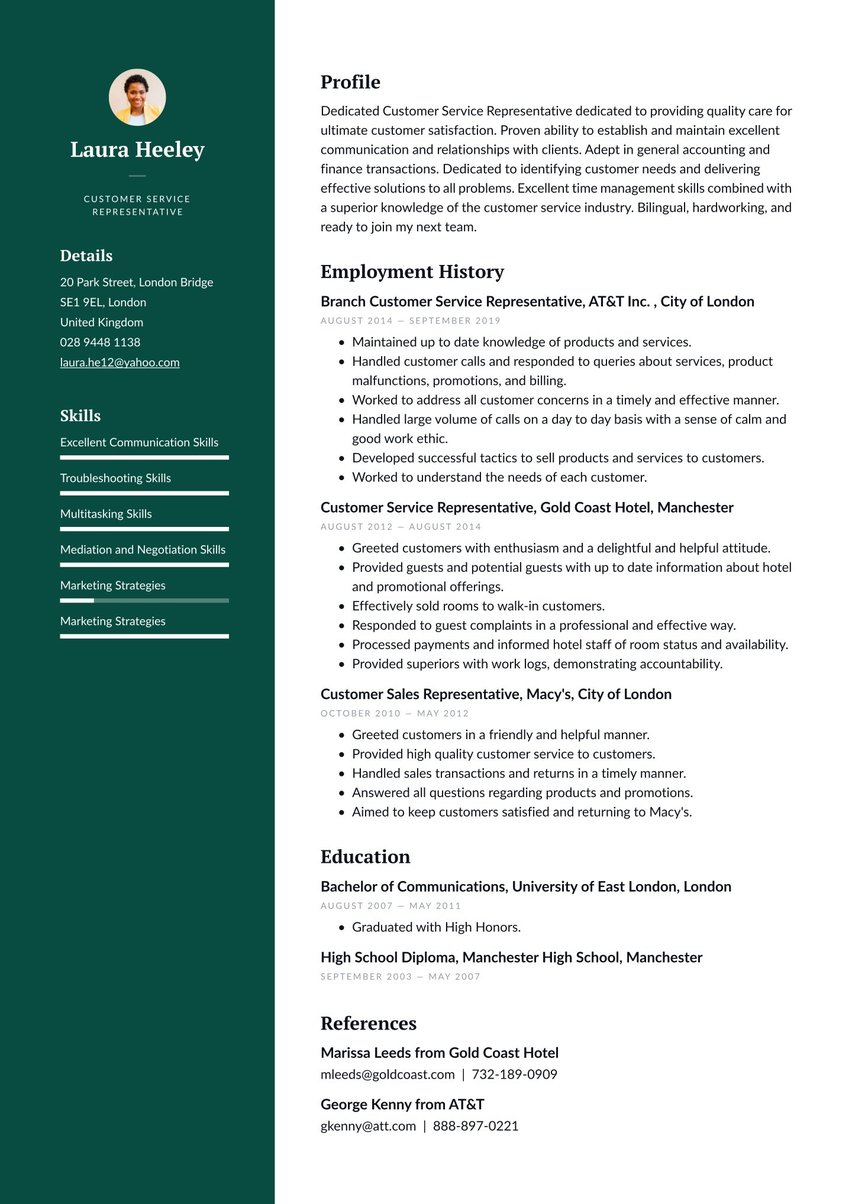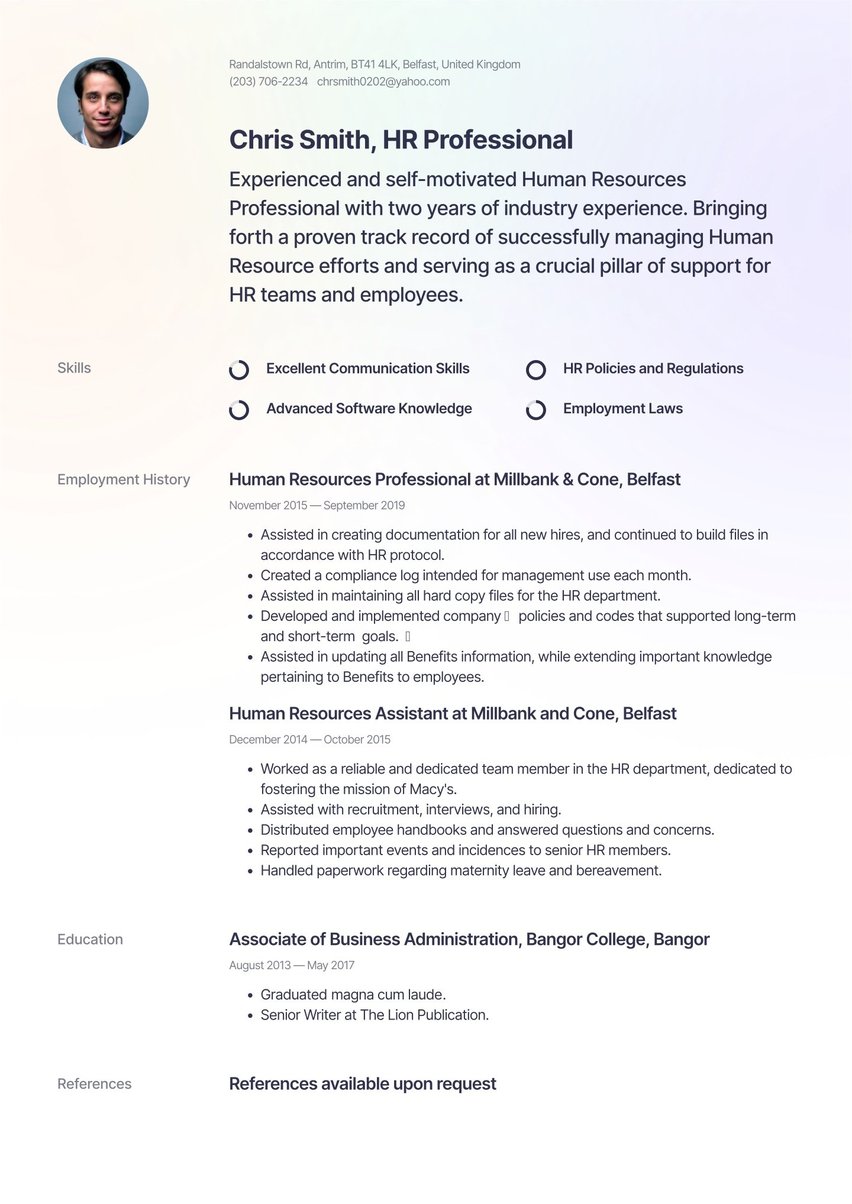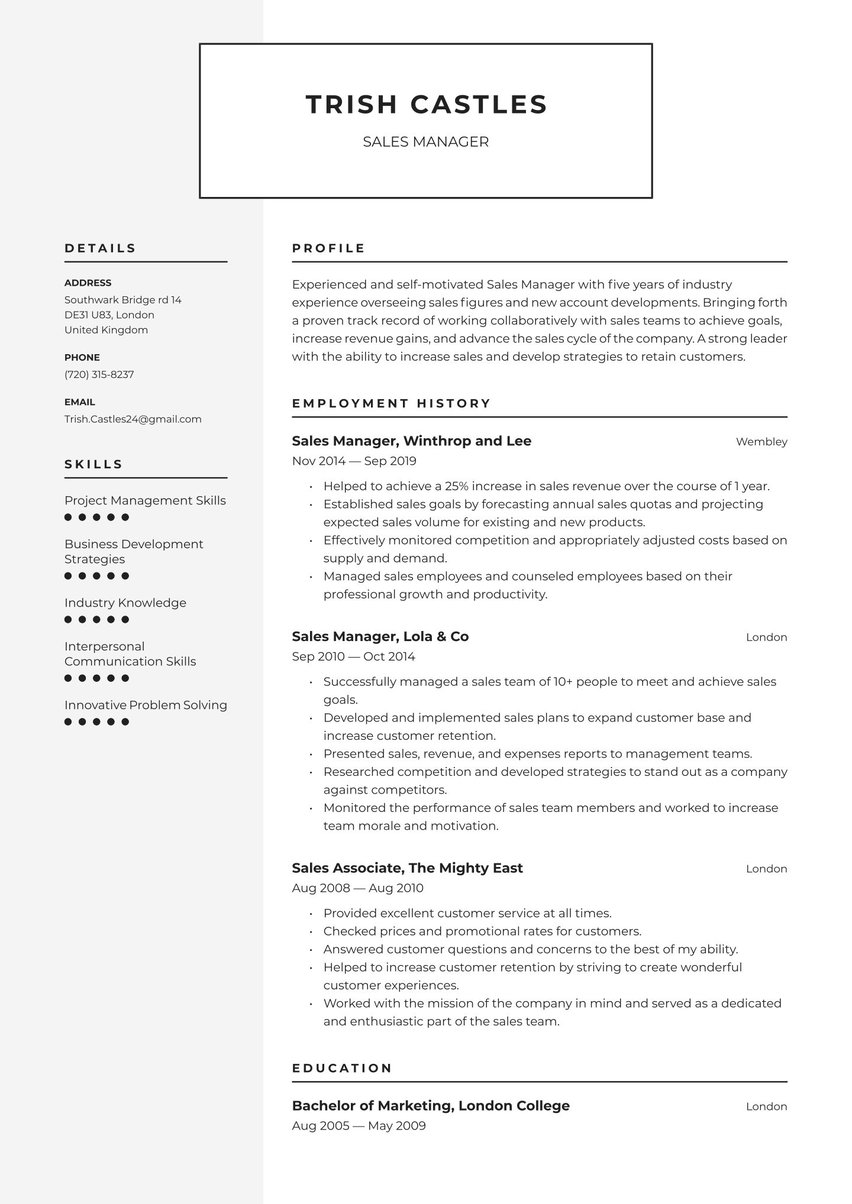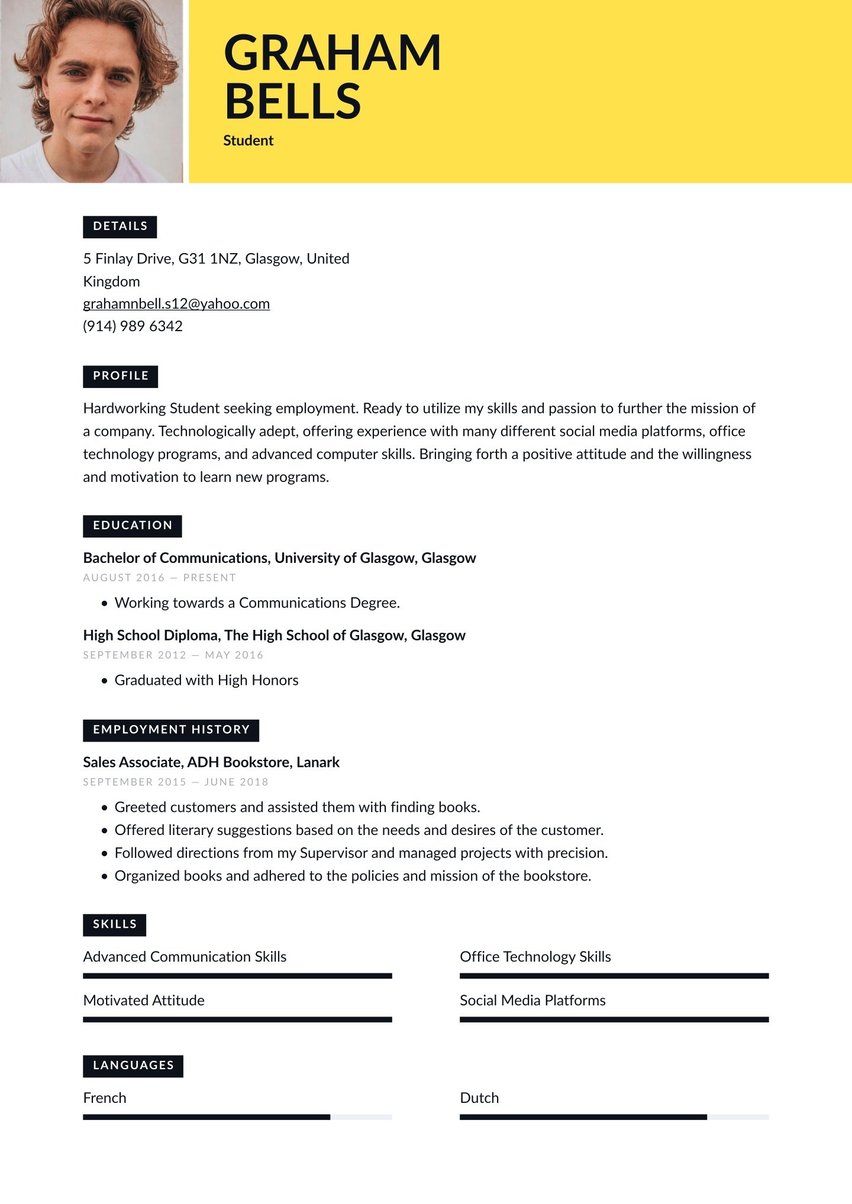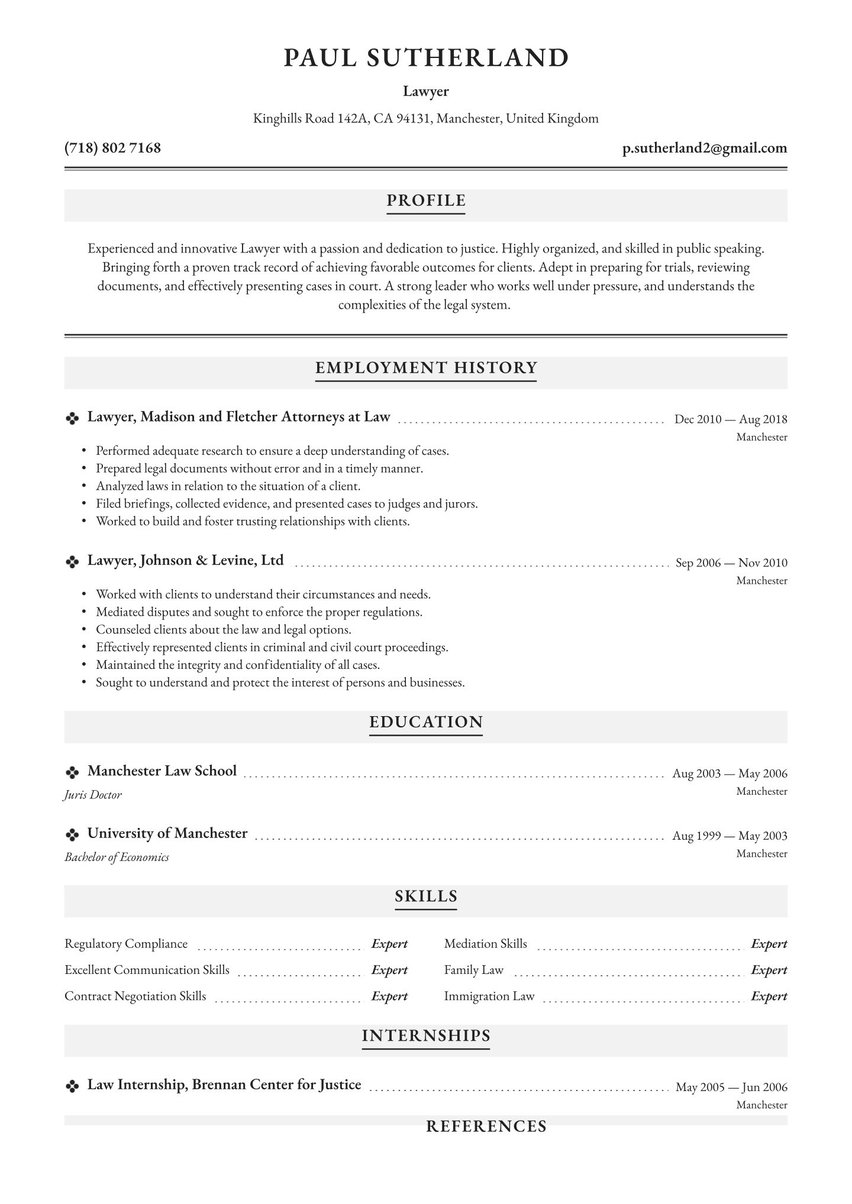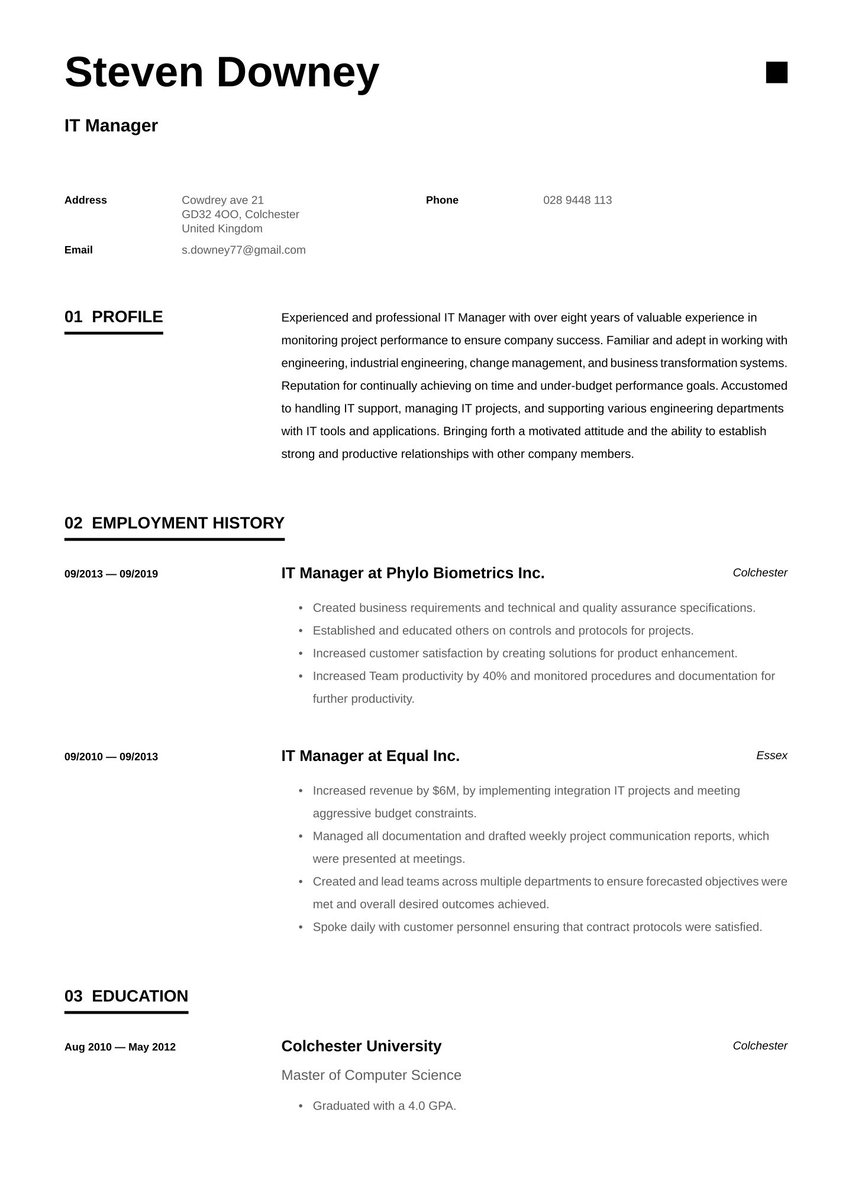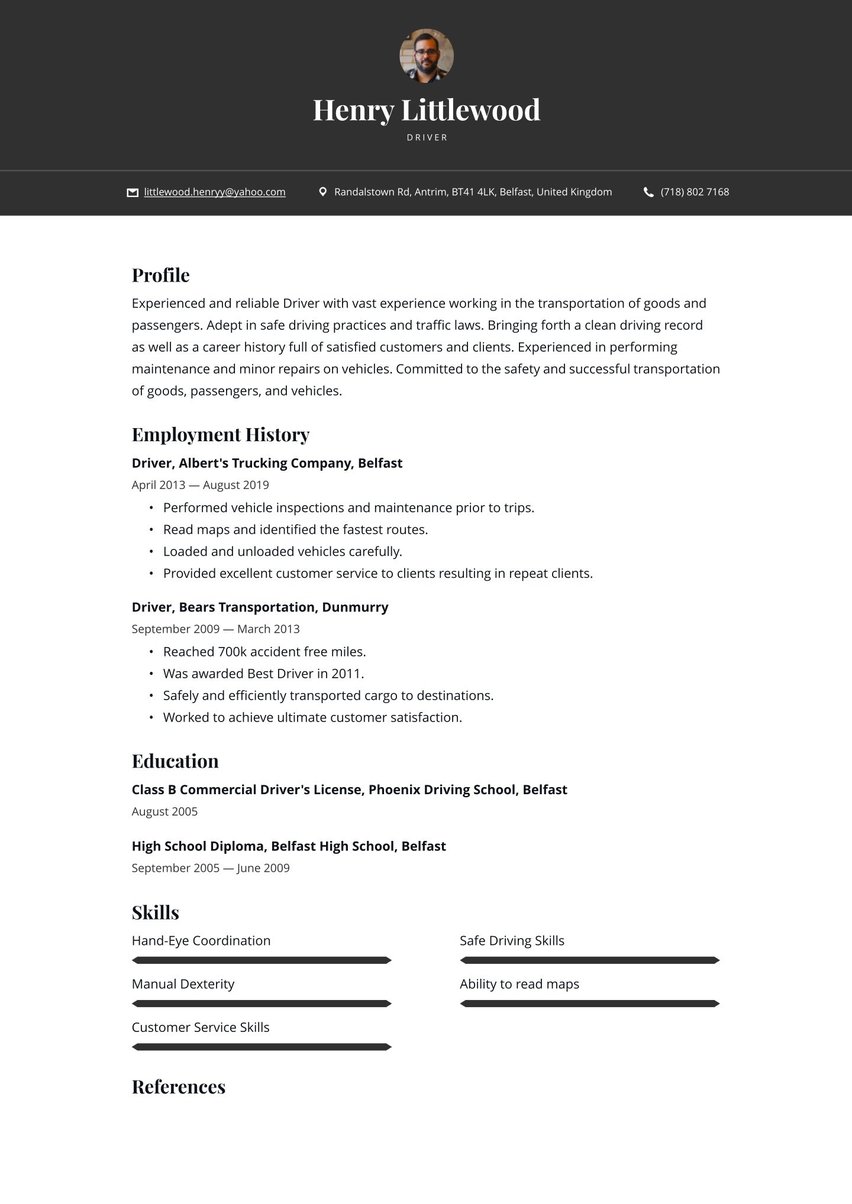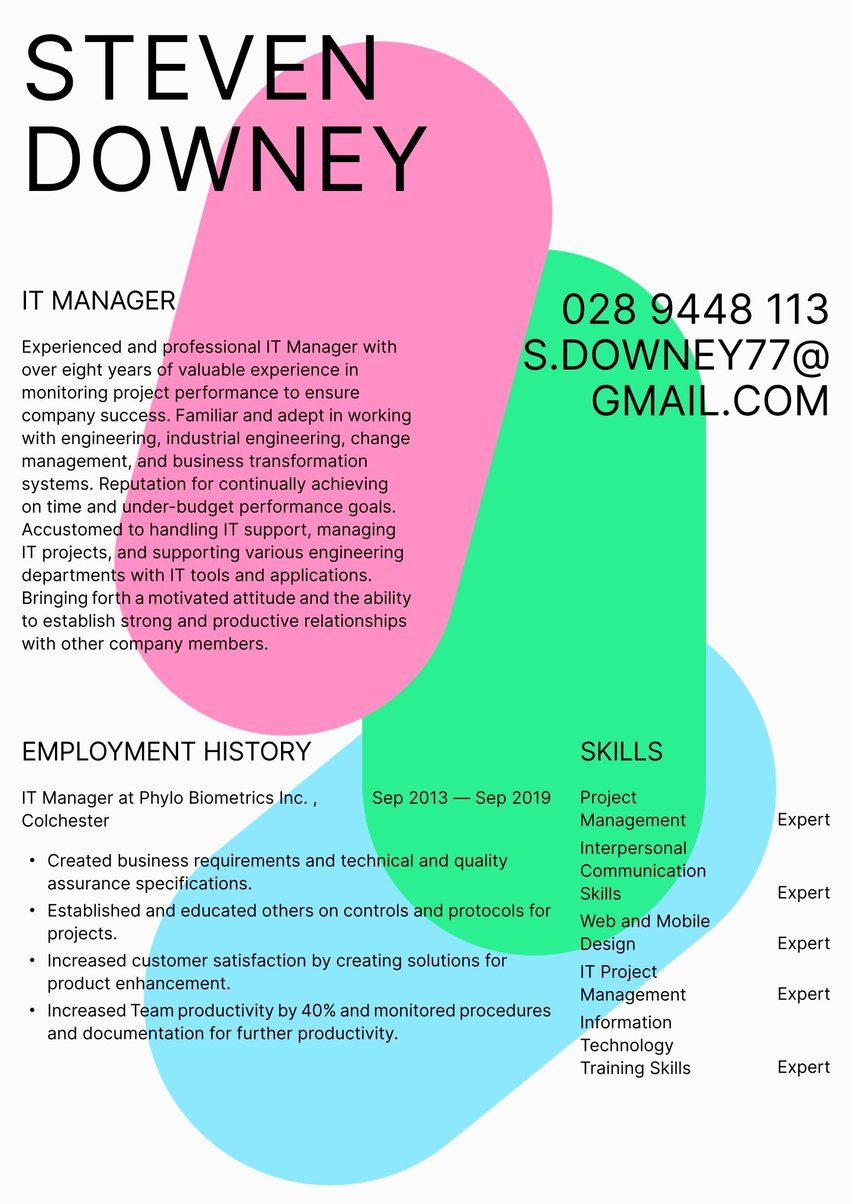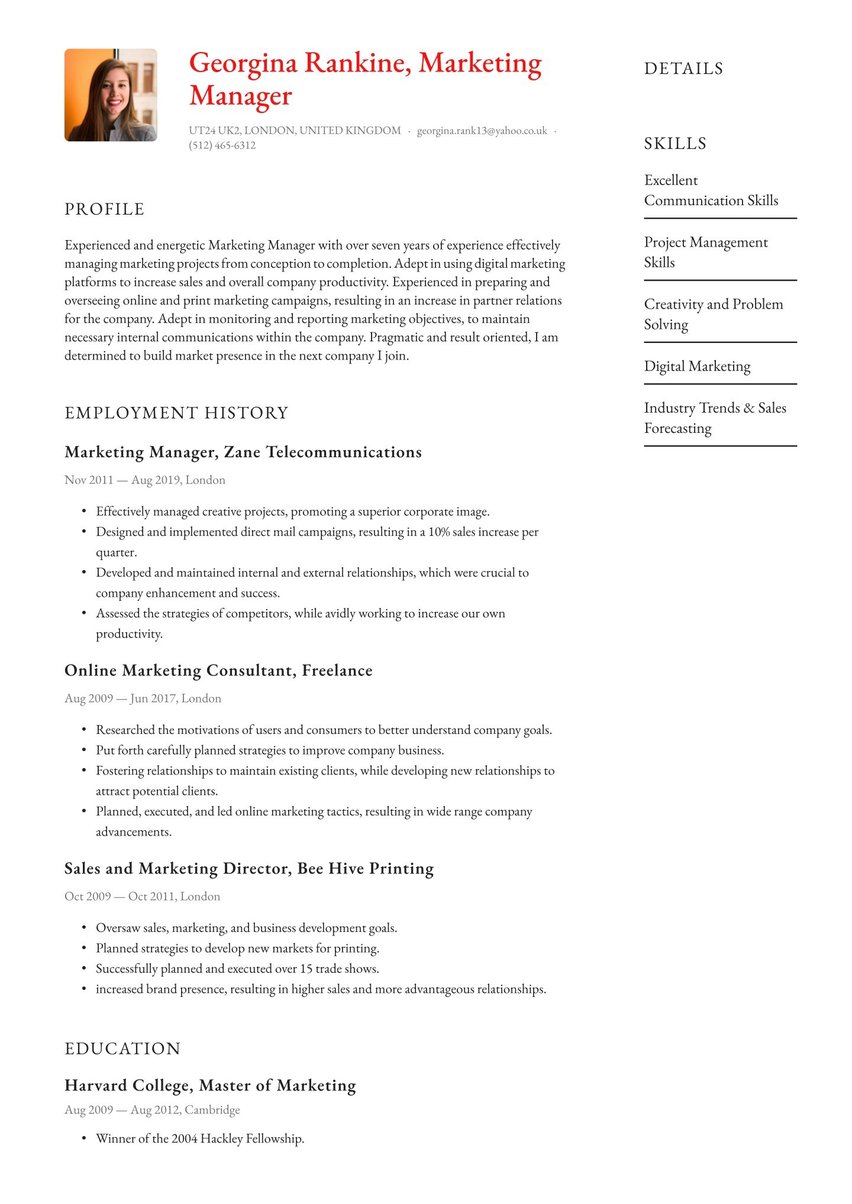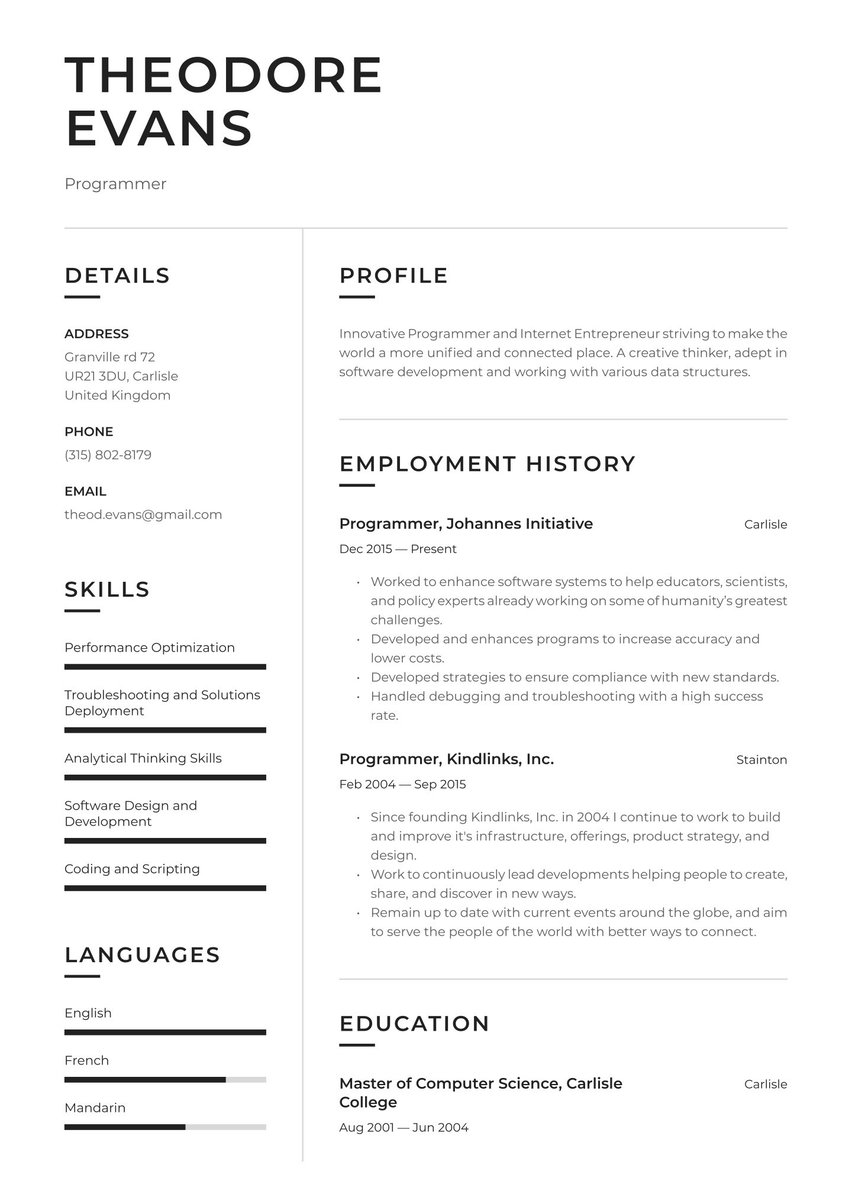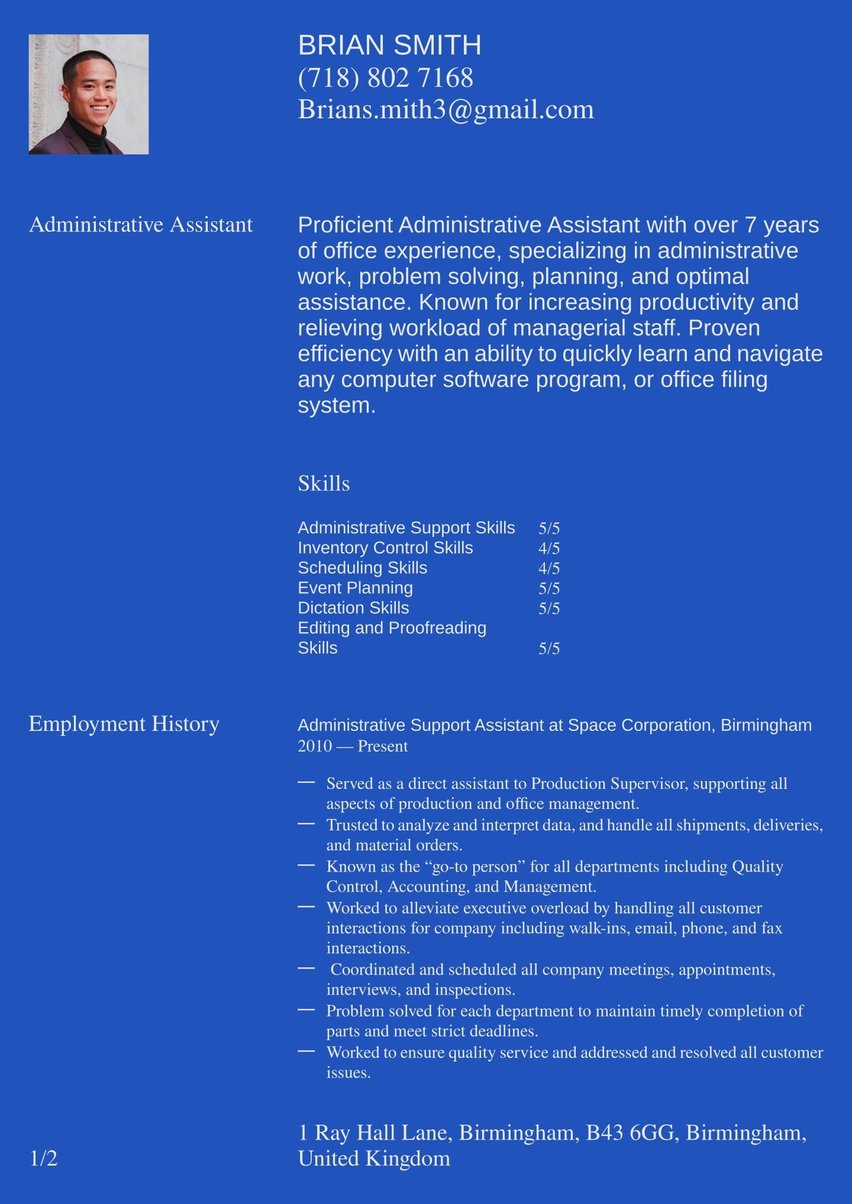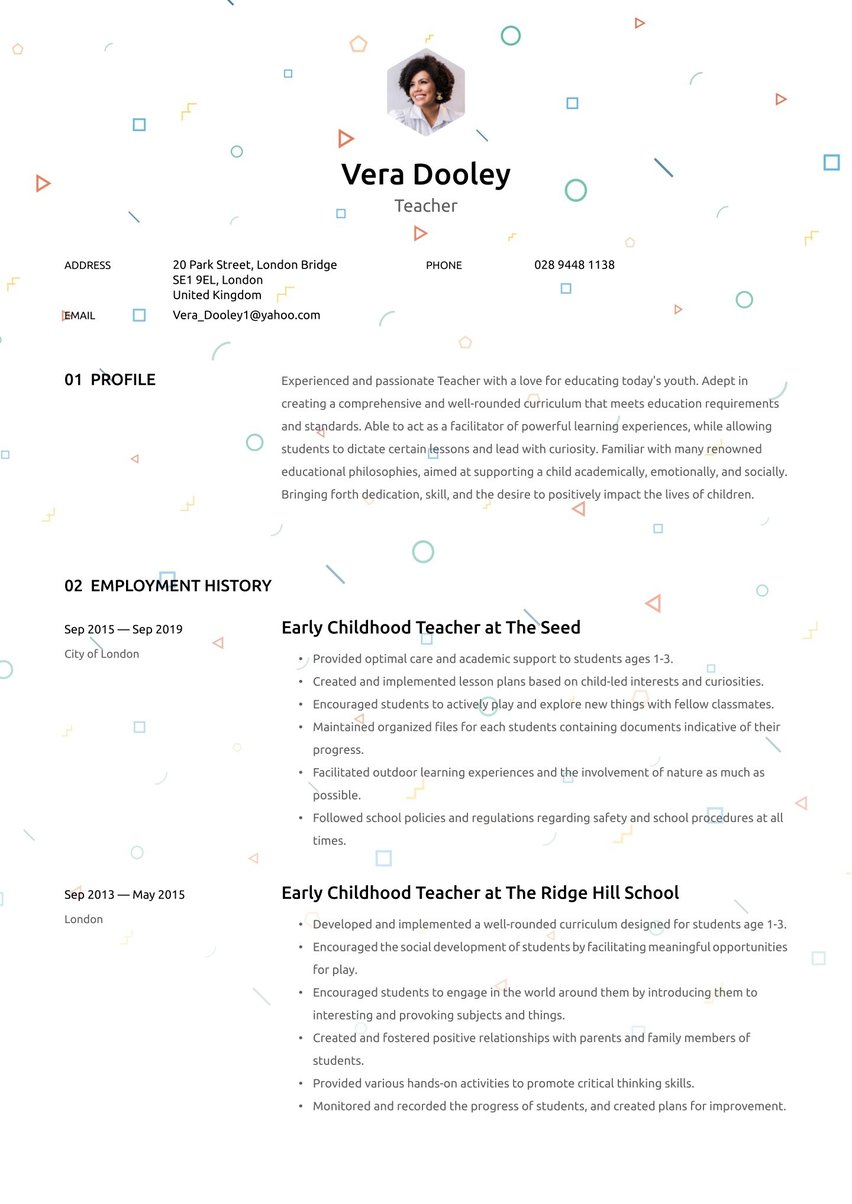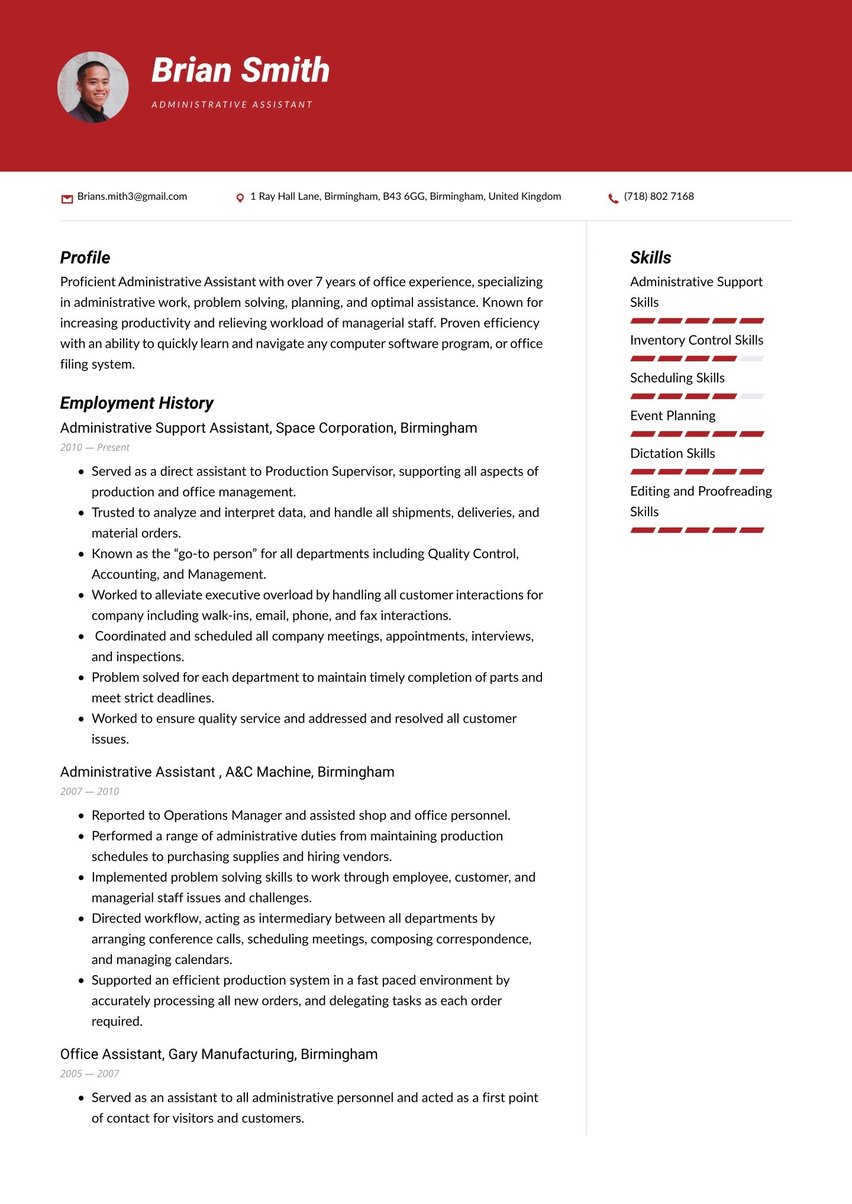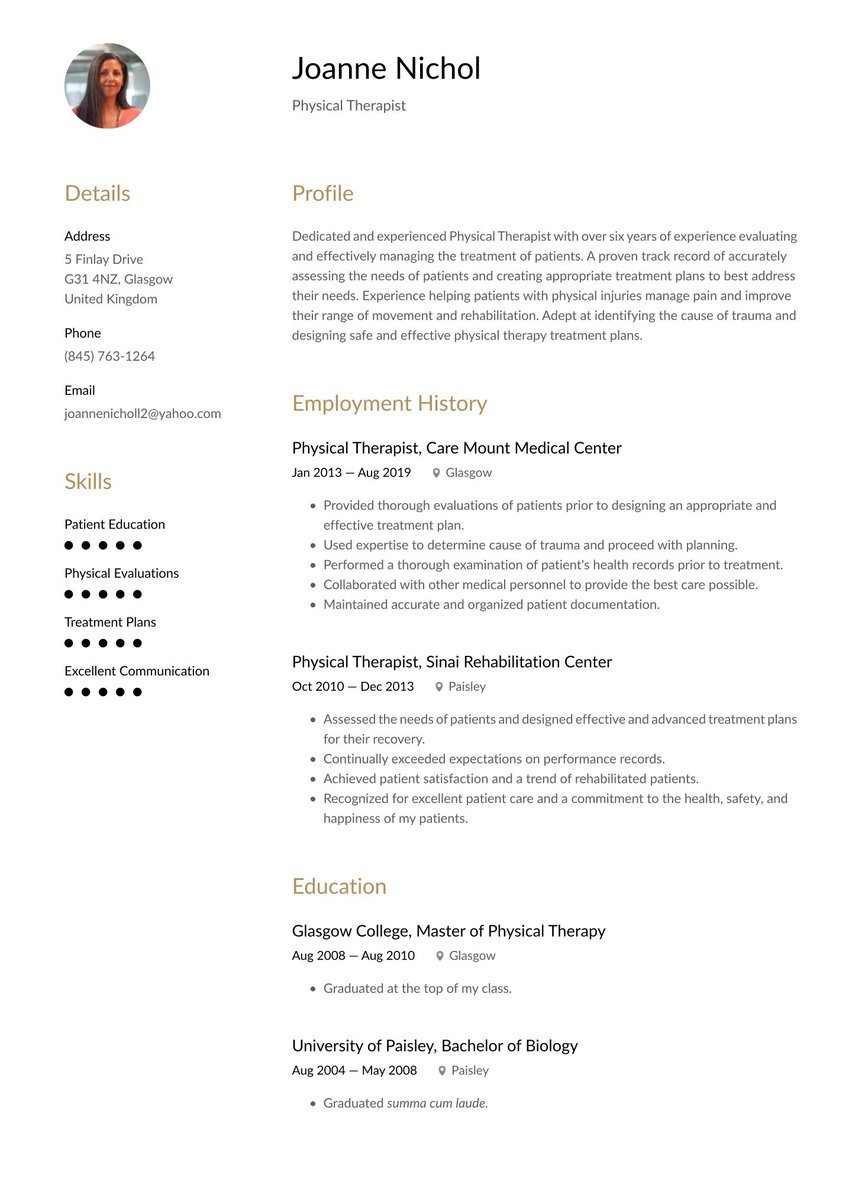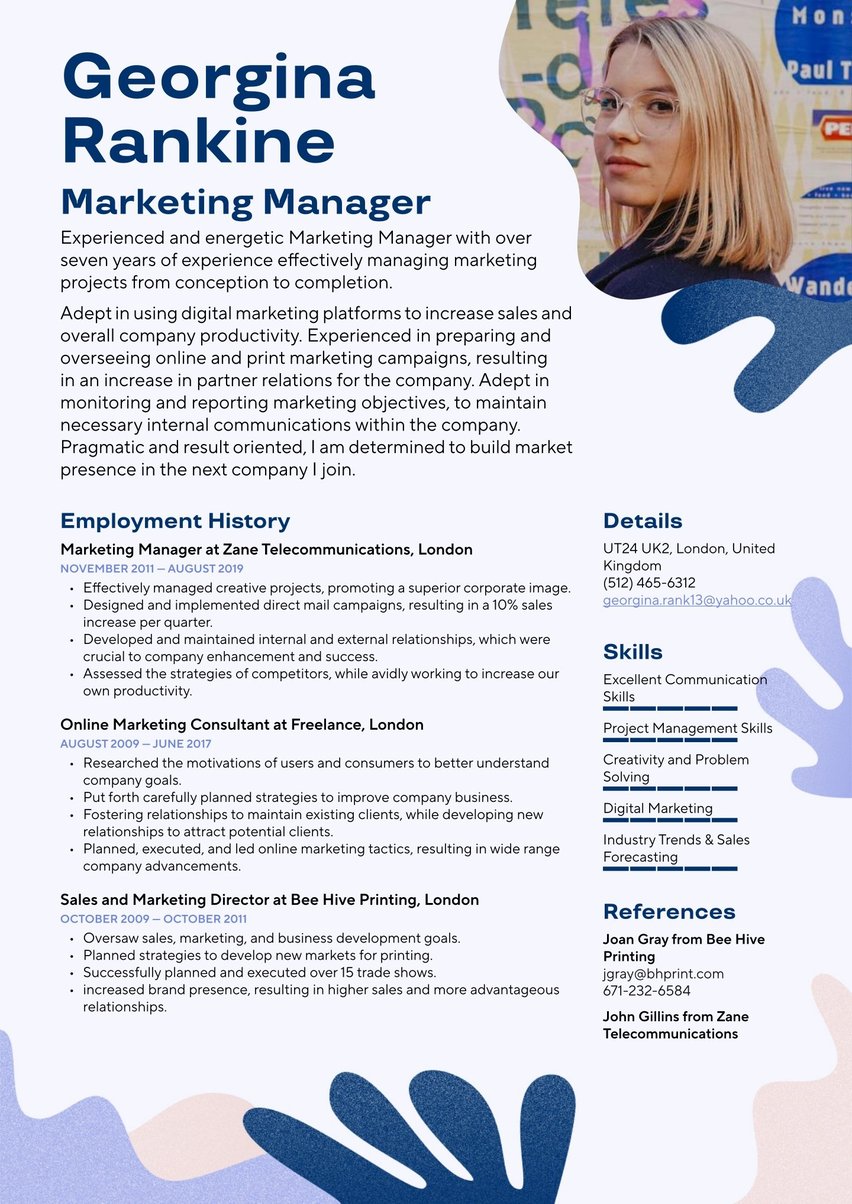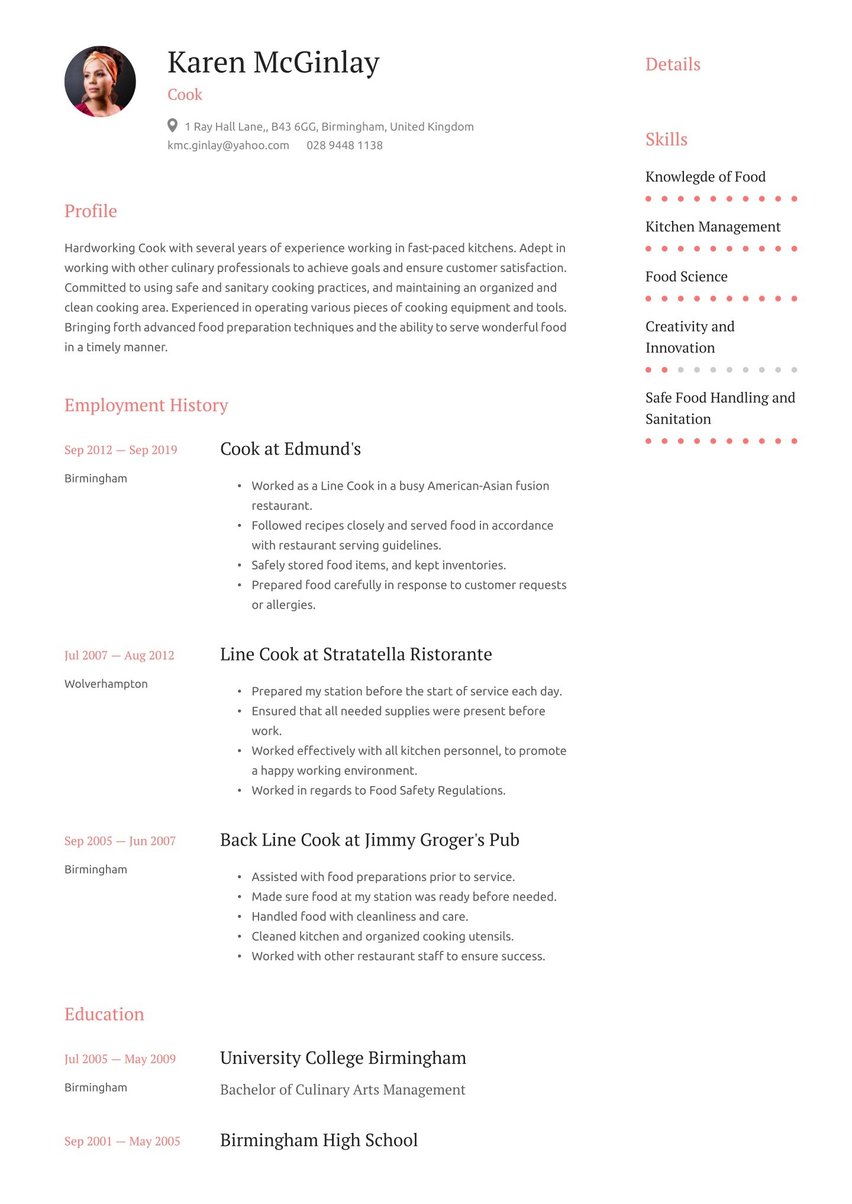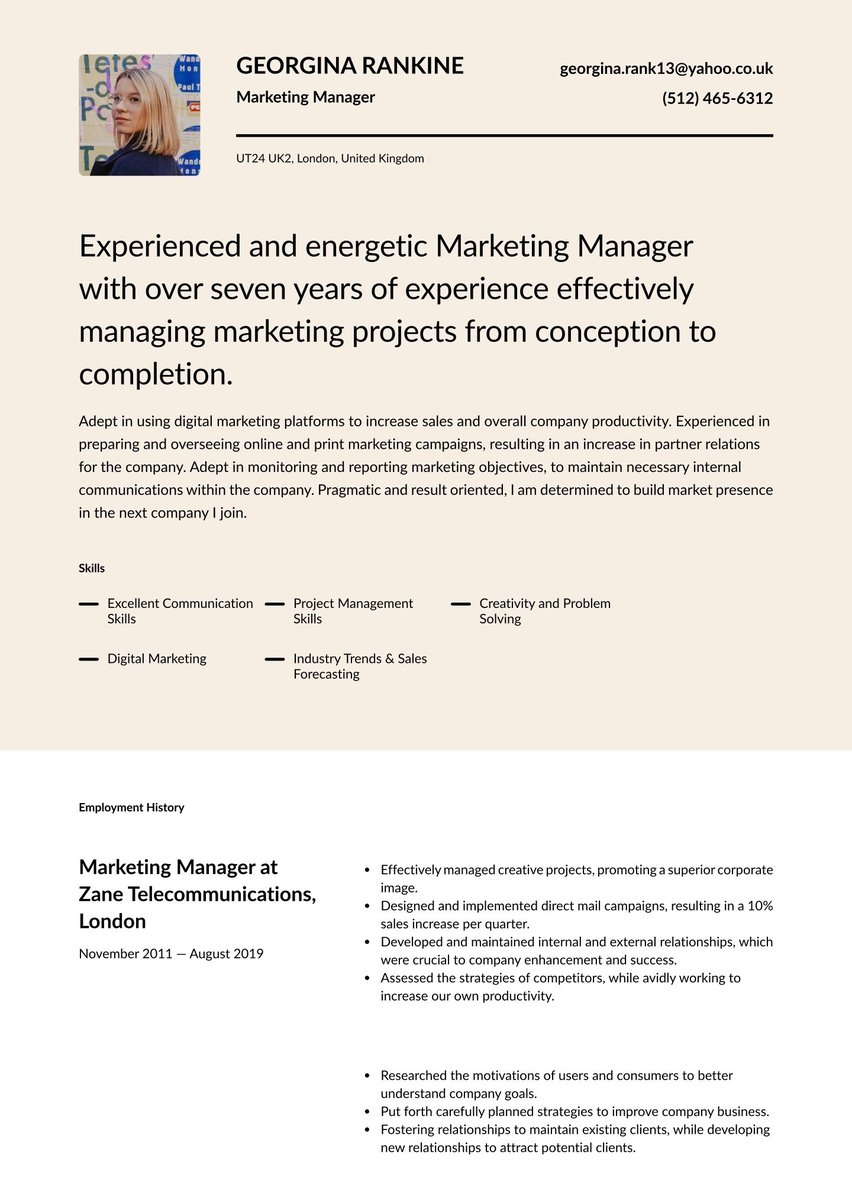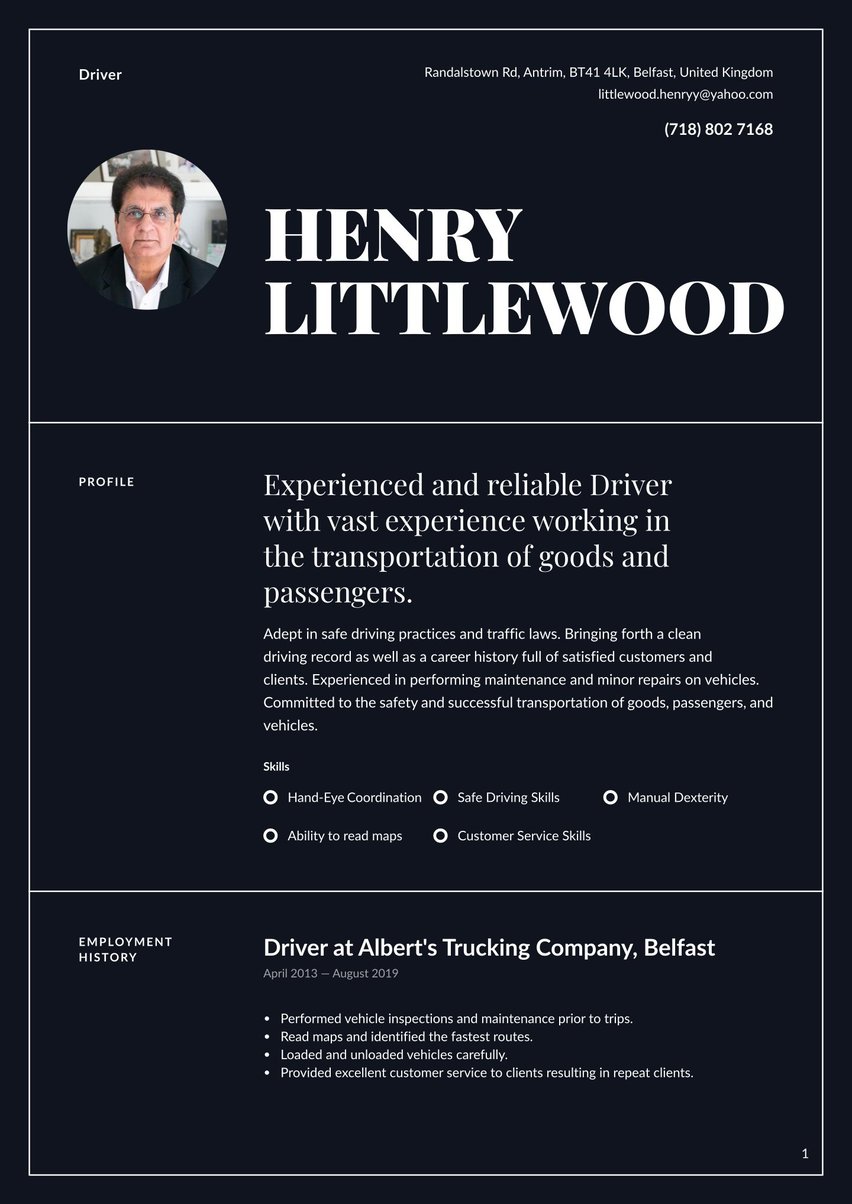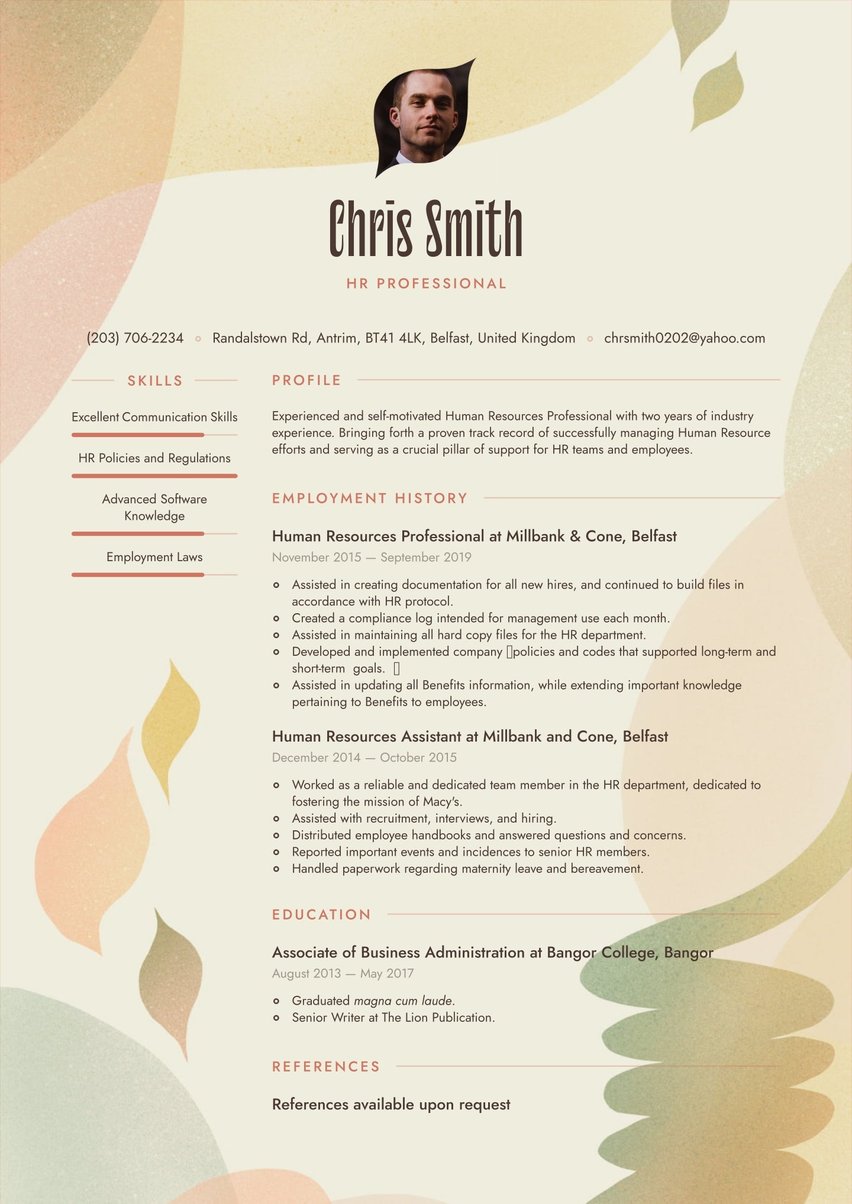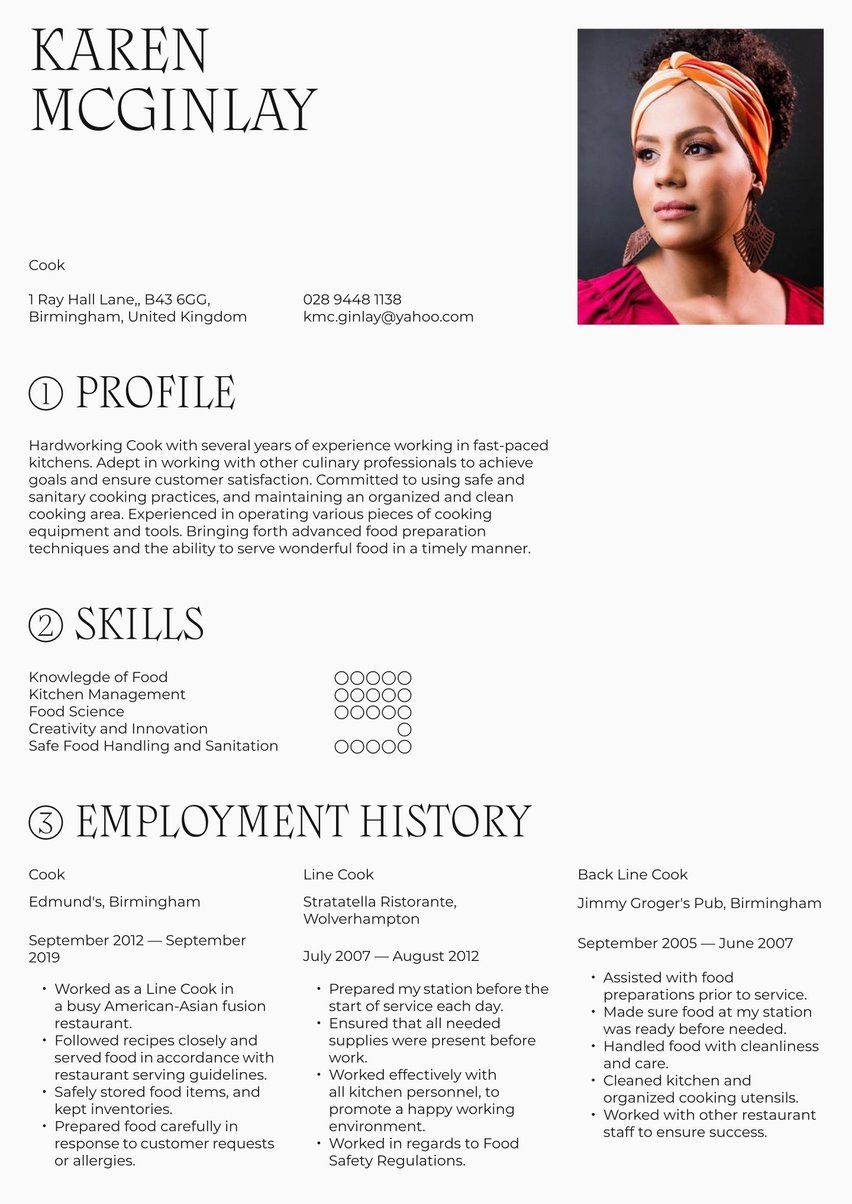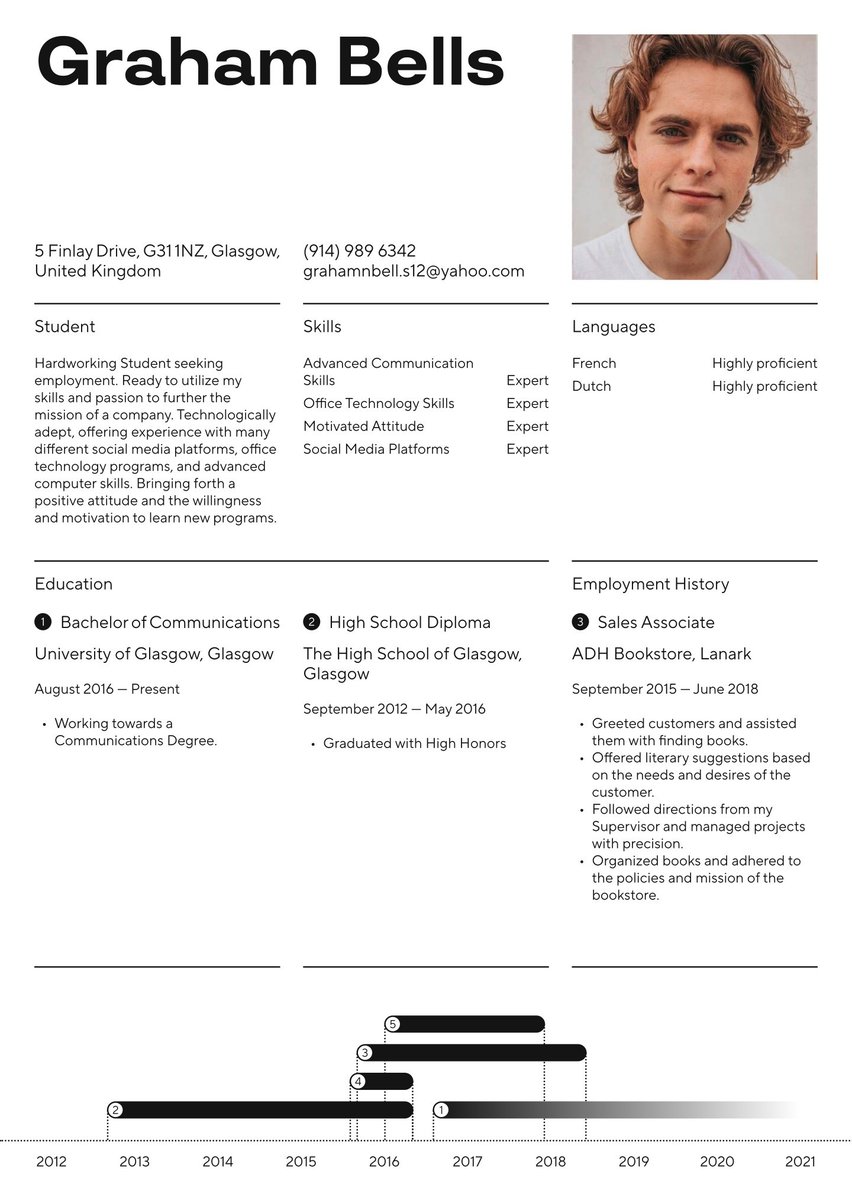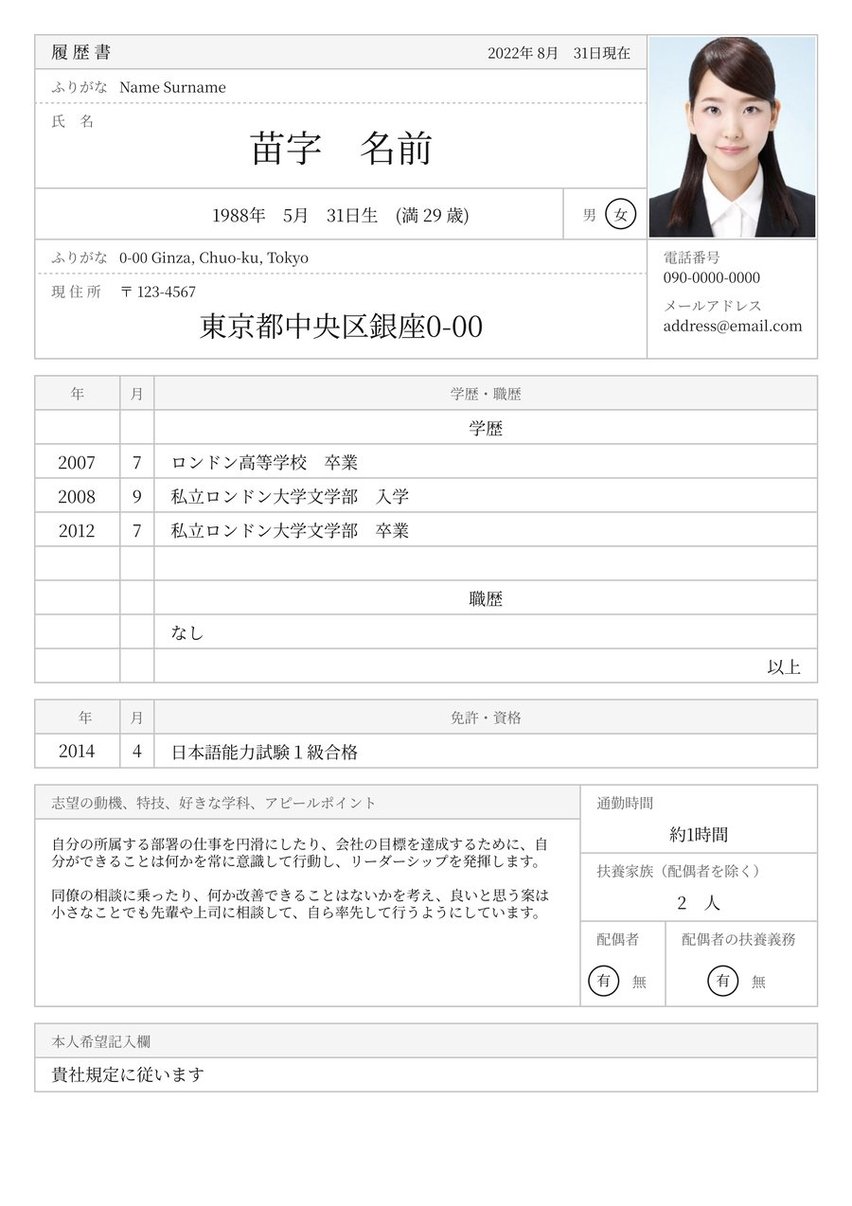Hardworking student seeking summer employment. Prepared to utilise my skills and passion to further the mission of a company. Offer employers a positive attitude, energy and motivation to learn new skills.
11/2022 - 01/2023, Sales Assistant (Seasonal), Next Retail Ltd, London
- Supported customers in locating desired products and provided information on product features.
- Handled cash and credit POS sales.
- Maintained store appearance by organising shelves and displays.
- Supported team members in inventory management and loss prevention.
07/2022 - 09/2022, Intern, Smith & Co. Accounting Firm, London
- Assisted in preparation of financial statements and reports.
- Collaborated with team members on financial analysis project which identified cost-saving opportunities.
- Gained proficiency in Microsoft Excel through daily use.
- Learned real world job skills from experienced employees.
09/2022 - present, , Kingsbury High School, London
- Teamwork
- Customer Service
- Fast Learner
- Microsoft Office
- Time Management
- Computer Skills
- Communication
- IT Skills
- Adaptability
- Cash Handling
- Retail Skills
- Inventory & Shelf Stocking
The time has come for you to go out and start making your own money. Writing your first CV and reaching out to local businesses is a rite of passage for every teenager. However, when faced with a blank screen and no clue where to start, taking the first step can be hard.
Relax. This is going to be far, far easier than you first imagine. Writing a teenager CV is simply about showcasing your skills and dazzling employers with your boundless enthusiasm. You have got this. Nobody expects you to be an expert in your field—they just want a keen worker who is ready to dig in and learn on the job.
If you’re ready to take the first step, you’ve come to the right place. Here at Resume.io, we just so happen to specialise in helping people land their perfect job. We have a wide library of CV examples and accompanying writing guides to help pave the way. As if that wasn’t enough, our team of experts serves up some of the best advice you could hope for in our handy blog posts. In this CV example and writing guide, we will be covering:
- The types of jobs that teenagers can apply for at different ages
- How to write a teenage CV and what you should include in it
- Advice on choosing the perfect CV format for your document
- Guidance on what you need to include in each section of your CV
- Expert-backed tips on how to design an application that looks the part
Want to go back to basics? Take a quick look at our comprehensive CV writing guide for a quick introduction to this process. We cover everything you could need to know!
How to choose the right job for you
Before we take a look at a CV template for teens, let’s talk about the type of job you should get. It may be your first time entering the workforce — but you still need to be picky. Here are some of the things you need to be on the lookout for when deciding on a first job:
Casual work
All work and no play is no way to spend your teen years. Be honest; you don’t want to dedicate all of your free time to a job. Apply for jobs that allow you a level of freedom and flexibility. Shift work or temporary gigs could fit the bill. For example, you might want to look for a casual job in a shop or even a paper round. Figure out what works for you.
Good experience
Your first job isn’t merely about putting money in your pocket—you can gain valuable experience here too. You may already know what career you want in the future. If so, consider applying for jobs that will give you the skills that you need to succeed. For example, if you plan on becoming a vet, consider working at a dog groomers.
The right atmosphere
Chances are, you don’t want to work in a stuffy old office—who would? So, take a moment to think about where you actually want to work. If you are a social butterfly, working in a cafe or shop gives you a load of face-time with the public. If you’re a confessed bookworm, you may want to work in a library and be surrounded by your favourite novels.
Do you know your legal rights?
Eager to take your first step on the career ladder? Here in the UK, we have strict laws about how old you need to be to get a job. Make sure you know your rights first! Here’s a quick breakdown of what you need to know, according to your age:
- 13-16 year olds
As the Children’s Society explains, you can get a casual job at the age of 13. However, there are some specific rules your employer needs to follow. For example, young people between the ages of 13 and 16 cannot work during school hours.
Additionally, young people in this age bracket can only work for a maximum of two hours on a school day or a Sunday. The total amount of hours you work per week during term time must not be longer than 12 hours.
When the school holidays come around, the legal requirements change too. When you are 13 or 14, you can work 25 hours per week during this time. If you are 15 or 16, you can work up to 35 hours throughout this period.
- 16-18 year olds
If you are between 16 and 18 years old, you can’t legally work more than 40 hours per week. You are also not legally allowed to work for more than eight hours in any 24-hour period. If you work more than four and a half hours, you have the legal right to a 30-minute break. If your employer is not following the law, don’t be afraid to speak up!
The best types of jobs for teenagers in the UK
Now that you know what to keep in mind when looking for your first job, it’s time to take things one step further. What types of roles are open to teenagers? While there’s a massive array of options out there, you might be scratching your head to think of any. Here are some of the typical positions that teenagers can land when they are just starting out:
- Babysitter. If you’re good with children, you might find that you can make some extra cash by looking after them. This is usually a casual arrangement. You might help the neighbours out when they are going out for the evening, for example.
- Barista. Are you a coffee connoisseur? If so, working as a barista in a cafe might be your idea of heaven. You will have to learn how to make the perfect cup of java, how to serve customers quickly, and what it takes to close down a shop.
- Shop assistant. If you fancy working one-on-one with customers, this one's for you. Most high street shops offer casual shift work. The demand for shop assistants also ramps up over the Christmas period when the shops get busier than ever.
- Tutor. Are you a whiz kid in the classroom? If you know how to ace your exams, you could make some extra cash by sharing your knowledge. Tutoring younger students is a fulfilling part-time job. You might do this through an agency or set out by yourself.
- Fast food worker. “Do you want fries with that?” If you’re a food lover, you might find that working in your favourite chain is the way to go. Yes, McDonald’s, KFC, Pizza Hut, Burger King, or even Taco Bell could be calling your name.
Think outside the box!
In this guide, we have highlighted some of the most common jobs for teenagers, but it doesn’t have to start and end there. If you have a special interest or want to work in a particular field, don’t be afraid to apply. The sky’s the limit!
How to write a teenager CV
Ready to start writing your teenager CV? Okay, we have the answers. The first thing you need to know is what to include. As a rule, your CV should have the following sections:
- The CV header
- The CV summary (aka profile or personal statement)
- The employment history section
- The CV skills section
- The education section
Now we know what you’re thinking. You don’t have an “employment history”. Don’t panic. Later in this guide, we will look at how to write a CV for teenagers with no experience. However, you should keep in mind that employers won’t expect you to have a ton of experience. Instead, they will be looking at the skills and interests that you have.
Always, always, always proofread!
Spelling mistakes are easy to make. However, when the employer reads your CV, they will be looking at the finer details. If you have typos, they will presume that you lack attention to detail. That could be the difference between landing the job and getting rejected.
Choosing the best CV format for a teenager
Picking the right format for your CV is one of the first steps in the process. Most employers expect you to use the reverse chronological approach. That means starting with your most recent experience and certificates and working your way back in time. While this is one option for your teenager CV, you should know that there are other formats you can use.
If you are applying for your first-ever job, you may not have any employment history. Rather than leaving a gigantic gap on the page, you can use a functional CV format. This structure places more emphasis on your skills than your experience, so it’s perfect for first-time job hunters. Read more about the different types of CV formats in our complete guide here.
Always tailor your CV well!
In this guide, we are looking at general advice about how to create a teenager CV. However, if you are going for a specific job, you need to tailor your application to it. With that in mind, here are some CV examples (and guides) that may suit your needs:
CV summary example
Here’s your chance to win over the employer. Your CV summary is a short paragraph that sits at the top of the page. Tell the reader why you want this job, what makes you right for it, and why they should choose you over the competition. By using persuasive language and emphasising your interest in the role, you can set yourself apart from other candidates.
Employment history sample
If you have had a job before now, list it in your employment history section. You should include the company, your role, and your dates of employment. Below that, add some bullet points revealing the tasks you completed on the job and what achievements you gained. If you’re not quite sure what we mean, take a quick look at our CV example for inspiration.
No experience? No problem!
If you’ve never had a job before, you may not have anything to include in this section. You may choose to use a functional CV instead or include other details. For example, if you have held voluntary positions or other roles in the community, you can list them here.
CV skills example
Next up, let’s conquer your skills section. You should bullet-point these in the appropriate section of your CV. Before you get started, consider what skills are needed for the position. You can usually find this out by looking at the job advert.
Be sure to include both hard and soft skills on your teenage CV. Hard skills apply directly to the role and are sometimes called technical skills. So, if you were applying to work in a shop, you might include “stock taking” as a hard skill.
Soft skills, on the other hand, can apply to a variety of jobs and help you work well with others. They may include “communication” and “time management”.
Teenager CV education example
Since you’re a teenager, you may still be in school or college. However, you should still include your studies in your education section. List the name of your institute, your years of attendance, and any exams you have completed. You can also include special awards or training here. Check out our CV example to help you get this right.
CV layout and design
Employers spend just seven seconds looking at each CV they receive. That’s not a whole load of time. You need to make the right impression immediately. To do that, make sure that the design you choose is clear and easy to read. You can add some pops of colour, but you don’t want to overdo it. Steer clear of any imagery and leave your headshot out of it.
Key takeaways for a teenager CV
- Landing your first job is a real milestone. However, before you get started, you should take the time to consider what type of role you want.
- Don’t panic if you don’t have prior experience. Use our guide to help you to write a clear and engaging teenage CV.
- Include a mix of both hard and soft skills to gain the reader’s attention.
Your CV design matters. If in doubt, use our field-tested CV templates to get it right.

